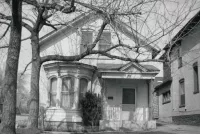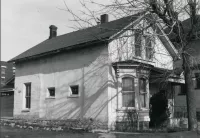Share what you know,
and discover more.
Share what you know,
and discover more.
Jul 07, 1983

-

- Charmaine Bantugan
National Register of Historic Places - Jeremiah Beattie House
Statement of Significant: The Jeremiah Beattie House, built in 1880, is significant as an example of the temple-form vernacular house type in Utah. This gable-facade, side passageway plan house is primarily associated with the Greek Revival architectural style and, as a vernacular form, is characteristic of the westward moving New England frontier. The house migrated to Utah with the Mormons in 1847 and is found here as one of several common mid-nineteenth century domestic architectural types. Its origins in the northeast, and its popularity in the northern Midwest document the New England background of the early Mormon religion. The Beattie House, built for a prominent Salt Lake City physician, displays stylistic features of the Italianate style, including hood mold or eyebrow window heads, and a projecting, bracketed bay window. Conceived during the Greek Revival, the temple-form house soon acquired a popularity which insured its persistence through several nineteenth century stylistic periods.3 The house type is found in Utah with Greek Revival, Gothic Revival, and Italianate decoration, and nicely illustrates the vernacular process by which individual examples display variation while the house type itself remains the same. The Beattie House is one of only nine documented Utah examples of the Greek Revival inspired temple-form vernacular house type.
National Register of Historic Places - Jeremiah Beattie House
Statement of Significant: The Jeremiah Beattie House, built in 1880, is significant as an example of the temple-form vernacular house type in Utah. This gable-facade, side passageway plan house is primarily associated with the Greek Revival architectural style and, as a vernacular form, is characteristic of the westward moving New England frontier. The house migrated to Utah with the Mormons in 1847 and is found here as one of several common mid-nineteenth century domestic architectural types. Its origins in the northeast, and its popularity in the northern Midwest document the New England background of the early Mormon religion. The Beattie House, built for a prominent Salt Lake City physician, displays stylistic features of the Italianate style, including hood mold or eyebrow window heads, and a projecting, bracketed bay window. Conceived during the Greek Revival, the temple-form house soon acquired a popularity which insured its persistence through several nineteenth century stylistic periods.3 The house type is found in Utah with Greek Revival, Gothic Revival, and Italianate decoration, and nicely illustrates the vernacular process by which individual examples display variation while the house type itself remains the same. The Beattie House is one of only nine documented Utah examples of the Greek Revival inspired temple-form vernacular house type.
Jul 07, 1983
National Register of Historic Places - Jeremiah Beattie House
Statement of Significant:The Jeremiah Beattie House, built in 1880, is significant as an example of the temple-form vernacular house type in Utah. This gable-facade, side passageway plan house is primarily associated with the Greek Revival architectural style and, as a vernacular form, is characteristic of the westward moving New England frontier. The house migrated to Utah with the Mormons in 1847 and is found here as one of several common mid-nineteenth century domestic architectural types. Its origins in the northeast, and its popularity in the northern Midwest document the New England background of the early Mormon religion. The Beattie House, built for a prominent Salt Lake City physician, displays stylistic features of the Italianate style, including hood mold or eyebrow window heads, and a projecting, bracketed bay window. Conceived during the Greek Revival, the temple-form house soon acquired a popularity which insured its persistence through several nineteenth century stylistic periods.3 The house type is found in Utah with Greek Revival, Gothic Revival, and Italianate decoration, and nicely illustrates the vernacular process by which individual examples display variation while the house type itself remains the same. The Beattie House is one of only nine documented Utah examples of the Greek Revival inspired temple-form vernacular house type.
Posted Date
Jun 16, 2023
Historical Record Date
Jul 07, 1983
Source Name
National Register of Historic Places
Source Website
Delete Story
Are you sure you want to delete this story?











